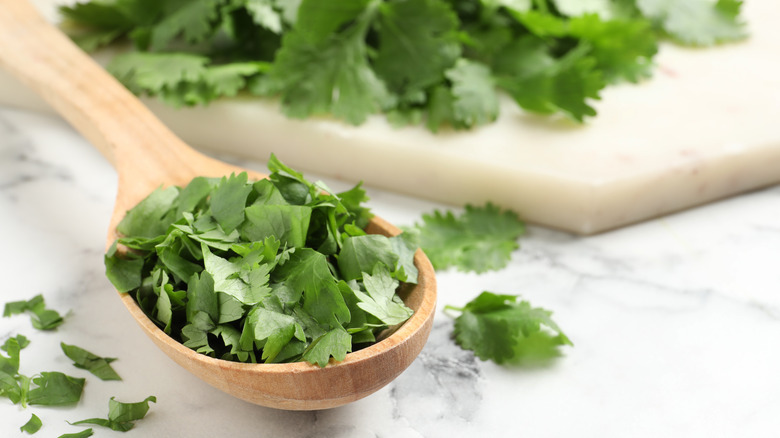Why Do Some People Hate Cilantro?
Hailing from the Mediterranean, cilantro has been flavoring dishes for thousands of years. Today, cilantro and its coriander seeds are integral parts of countless cuisines around the world, including Mexican, Thai, Indian, and more. However, despite the herb's prevalence, there is a percentage of the population that cannot stand its taste. To some, cilantro has a bitter, soapy taste rather than a bright, citrusy one. While it is possible to simply not like the flavor of cilantro, for some people, the source of their disgust lives in their DNA.
Cilantro contains an organic chemical known as aldehyde. Aldehyde appears naturally in many foods, including peas, cinnamon, and vanilla. Along with these natural occurrences, synthetic aldehydes are also used to make products like soaps, detergents, and perfumes such as the famous Chanel No. 5. Throughout the years, various studies have determined that some people are born with a gene called OR6A2 that is particularly sensitive to aldehydes. According to a study from Cornell University, "OR6A2 may be the olfactory receptor that contributes to the detection of a soapy smell from cilantro." Simply put, if you have the OR6A2 gene, you are likelier to dislike cilantro due to its soapy taste.
It's (mostly) about genetics
A study published in the journal Flavour found that the percentage of people who dislike cilantro is anywhere from 3 to 21% of the population. Interestingly, a person's ethnicity seems to significantly impact whether or not they enjoy the herb. Per the study, "the proportion of subjects classified as disliking cilantro was 21% for East Asians, 17% for Caucasians, 14% for those of African descent, 7% for South Asians, 4% for Hispanics, and 3% for Middle Eastern subjects."
Looking at these numbers, one could assume that the closer a person's ancestors lived to where cilantro was first cultivated in the Mediterranean, the less likely they are to dislike it. But this disregards the importance of culture regarding one's culinary preferences. In an interview with the New York Times, neuroscientist and former cilantro-hater Jay Gottfried explains that while cilantro is still reminiscent of soap to him, the more he eats it, the more he's able to associate it with positive experiences like enjoying a meal with friends. "That's how people in cilantro-eating countries experience it every day," he says. So, if you live in a region where cilantro is especially popular, if you eat it regularly, you're more likely to enjoy it even if you have the gene that highlights its soapy taste.
Hope for cilantro haters
Gottfried's experience shows that it's possible for those genetically predisposed to detest the taste of cilantro to learn to love it. The New York Times article's author, Harold McGee, recommends beginning your journey of cilantro tolerance by making pesto with ground cilantro since it has been proposed that "crushing the leaves will give leaf enzymes the chance to gradually convert the aldehydes into other substances with no aroma." Spread your cilantro pesto onto some good toast and enjoy it in a comfortable environment to create positive associations with the taste.
Of course, whether you have the OR6A2 gene or not, there is nothing wrong with hating cilantro. Cilantro also contains the natural compound linalool, which is also used in some mosquito repellents, so it makes sense that the taste is simply too similar to chemical products for some people. Even the legendary chef Julia Child hated cilantro and would opt to pick it out of her food and toss it away (via Nature). If you're planning a trip to a cilantro-loving country, it might be beneficial to learn to love this polarizing herb. Otherwise, don't fret over your discerning tastes, and rest assured that it's not you — it's your DNA.


